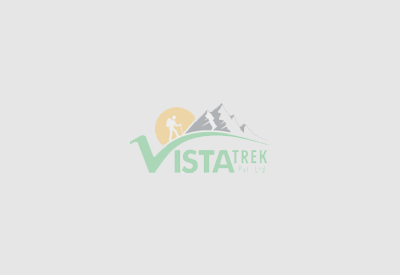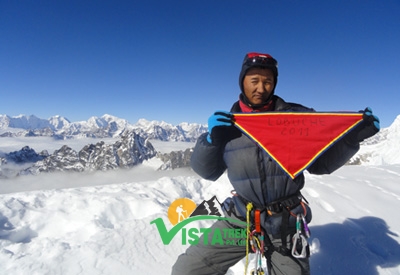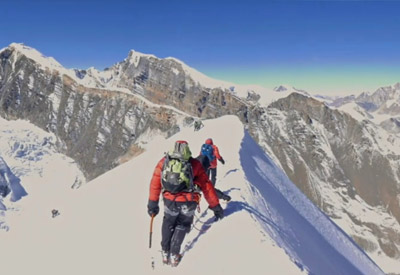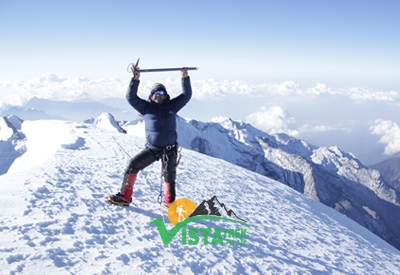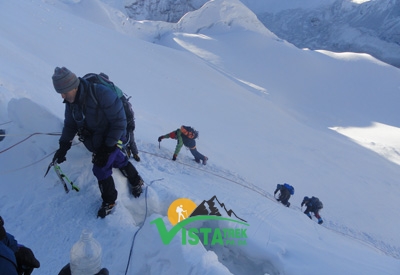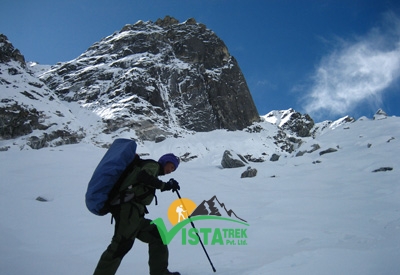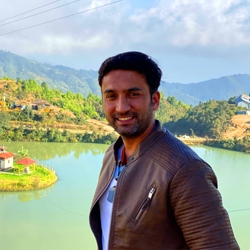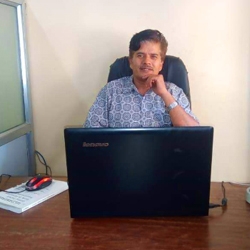Trip Facts
- Trip GradeEasy
Trip Highlights
- Have wonderful views of surrounding peaks from the summit of Island Peak.
- See Ama Dablam, Everest, Makalu, Lhotse, Nuptse, and Pumori from an incredibly close distance.
- Stay at the Sherpa capital of Nepal – Namche.
- Experience a challenging and introductory climbing trek in Nepal.
- See Lhotse Glacier right in the heart of Khumbu Region.
Trip Overview
Go on a journey to Island Peak, where you will have crystal-clear views of several Himalayan peaks. Some of the mountains see up close are Ama Dablam, Everest, Lhotse, Nuptse, Pumori, and Makalu. The Island Peak climbing program from Vista Treks takes you to for a wonderful adventure in the Himalayas. Located at the vicinity of Mt. Everest, Island Peak rises prominently above the beautiful Lhotse Glacier. At 6,189 meters, Island Peak is most climbed peak in Khumbu region.
From the top of Island Peak, you will have unobstructed panoramic views of mountain far and wide – including peaks of Makalu, Amadablam, and Tawache, Cholatse And while on the trek you will sleep in traditional Sherpa villages with their unique lifestyle, mores, and cultures. Nestled inside Sagarmatha National Park, this trip is your chance to immerse in a unique geographical diversity in Nepal.
This combined climbing and trekking program to Island Peak begins with a quick 30-minute flight to Tenzing-Hillary Airport in Lukla. Here, you will begin the actual trekking and arrives in Chhukung Village passing through other beautiful villages like Phakding, Namche, Tengboche , Pangboche and Dingboche.
To summit this peak, you need to be physically fit but not necessarily an experience of climbing a peak. As this program does not demand technical skills, the basic skills of using ice-picks and crampons that you need to scale Island Peak, will be taught by our guide and team leader. Albeit a challenging trek near Island Peak, the rewards are much heavier than the efforts. Along the way you will have ample time to practice the skills and put them to test later on.
The best season to climb Island Peak is in the summer (March, April May) and in the autumn September, October, November). Book this trip from Vista Treks for an introductory and satisfying peak-climbing experience in Nepal.
Trip Itinerary
- Upon arrival at Tribhuwan Intl Airport in Kathmandu, a representative from Vista Trek waiting, well in time, to receive you shall welcome you to this land of towering Himalayas. Once reaching your hotel in a car from the airport, all you need to do is check in and enjoy the refreshment served.
- We then visit the Vista Trek office for discussion on trekking, introduction to the guide and porter and settlement of dues if any. Since you will still have some time left for a walk around Thamel, you can do so if you please.
- We fly to Lukla from Kathmandu in the morning. This 30-minute flight comes with spectacular views of the hills and the Himalayas, forcing many to take their cameras out or simply use their mobile phones with attempts to capturing the beauty.
- We walk to Phakding Village for 3 to 4 hours after breakfast in Lukla. The trail is relatively comfortable and passes through four Sherpa villages. Houses with stone walls and colorful roofs, huge prayer stones with mantras from the teachings of Buddha carved in them, monasteries with busy budding Lamas, several mountains already in sight and rivers and waterfalls along the way, the trail already offers us a glimpse of what to expect.
- Once in Phakding, one thing we can do is walk around the village or just relax on a bench in the porch of the hotel and absorb as much as we can after lunch.
- Spend the night in a hotel.
- After breakfast, we walk for about 2 hours to Jorsalle Village for lunch. The route starts along the banks of Dudhkoshi River and crosses two suspension bridges before reaching Monjo Village. A 20-minute descent towards the end, finally, leads to Jorsalle Village, the entrance to the Sagarmatha National Park as well as the last village until Namche Bazaar.
- After lunch, we walk for around 3 hours to Namche Bazaar. With the raging Dudhkoshi River mostly to the left for about half an hour before crossing a suspension bridge, the trail in its final 2 hours ascends through a pine forest. In reaching Namche, the administrative headquarter of the Khumbu Region, the ascent often demands a little extra even from seasoned legs.
- Spend the night in a hotel in Namche.
- It’s time for a trip to Sagarmatha National Park Museum after breakfast. Most people use their time at the Museum trying to gain some insight into the Everest Region – about the highest peaks, animals and vegetation that rule the region as well as the Sherpa culture and experiences of many trekkers and climbers.
- We then leave the Museum and walk for about an hour to the Everest View Hotel for lunch. Constructed on a site in an altitude higher than any other on earth and ideally positioned, the hotel presents all its guests with ample individual space to appreciate the grandeur – a typical Sherpa village in the Khumjung Valley below to the North-West; on a hilltop above the village, the Khumjung Monastery, where a preserved skull which the locals believe to be that of a Yeti can be witnessed upon request; Mt Khumbila, a massive rocky elevation worshiped as a deity by the locals and, thereby, a restricted peak for climbing, right above the valley; and to the North, captivating views of the Himalayas, including Mt Everest, Mt Lhotse and the beautiful AmaDablem.
- After climbing down to Namche Bazaar in the afternoon, a walk around the Bazaar is a preferred involvement to some and indulgence to others.
- Spend the night in the hotel.
- We start trek after breakfast and stop at Thanga for lunch after about 3 hours’ walk. The comfort of the trail up to Kyangzuma Village ends with the moderately challenging descent to Thanga. In Thanga, a pretty small settlement with three constructions at most, the trek stops for lunch in a teahouse. While the food is prepared, many people find waiting an experience of its own – the rumbling of Dudkhoshi River from the deep gorge below reaching the eardrums from the right, the eyes exploring the presence of the pine and rhododendron trees densely populated in the area, a gentle breeze caressing the hair while waiting for lunch hungry after several hours of walk.
- After lunch, we walk for around 3 hours to Tyangboche. From here on, the trail ascends sharply mostly through forests filled with pine and rhododendron trees all the way to Tyangboche. A spectacular view of the beautiful Mt AmaDablam meets the eyes as soon as they enter the village. The next to capture the attention is the biggest monastery in the Khumbu Region, the TyanbocheMonastry. The settlement presents a typical picture of a village in the laps of the Himalayas – houses made of stones in a cluster separated by narrow alleyways, a monastery and/or a temple highlighting the beliefs of the people, people going about displaying a simple way of life, a forest nearby, a river flowing pretty close and between two the snow caped Himalayas.
- Spend the night in a hotel in Tenngboche.
- After breakfast, we walk for about 3 hours to Pangboche Village for lunch. With a downhill to the village of Diboche before a long gradual ascent, through a rhododendron forest, across a bridge, the trail finally brings its travelers to Pangboche Village. With narrow footpaths carved along the edges of hilltops, parts of the route demand alertness while being constantly drawn by the breathtaking views on offer in front, now that Mt AmaDablam gets closer and closer with every step forward.
After lunch in Pangboche, we start walking again for about 3 hours to Dingboche. With the magnificent Mt AmaDablam to the right all the time, this course triggers some contemplation into the phenomena in the immediate environment along the way – yaks with loads on their backs walking in a file, a tahr jumping care freely on slopes only perhaps the most daring would think of giving a shot at and a male impeyan pheasant – the national bird of Nepal – dancing with a hope to impressing a female nearby who till now seems to simply be turning a blind eye … a smile and a gentle shake of the head in sincere appreciation of the visually appealing yet intellectually challenging ways of things.Dingboche, with around forty households, is home to approximately two hundred locals. - Spend the night in a hotel in Dingboche,
- After breakfast, we pack our lunch and go up a steep climb for around three hours to NangkarTshang at an altitude of 5,616 metres. From this vantage point, the view when facing Norht includes Mt Lothse and Mt Nuptse in the front, LotseShar and Peak 38 and Island Peak to the front-right, Mt AmaDablum to the right, Mt Thamsherku, Mt Kantega and Taboche Peak to the back and CholaTse Peak and Lobuche Peak to the left.
- After spending some time in NangkarTshang, we come back to Dingboche and spend the night here.
- After breakfast, we start our walk to Chukung. Its only two and a half hours comfortable walk to Chukung. Chhukung is a smalle settelments where only about half a dozen guest houses are available. We check-in in one of them.
- After Lunch we make sure that our climbing gears are all in preferred conditions. We will hire some gears if necessary and explore around the rest of the day.
- We spend the night here.
- Our walk, after breakfast, lasts for roughly four hours on a path that is a slight uphill. Once in the Base Camp, it is at the side of Imja lake we camp, with Lhotse Glacier to the East and the West. After some necessary training, which often lasts for around an hour, we sleep early as the next day demands that we get up pretty early.
- Overnight at tent camp.
- Today, we get up very early, at around 1 am. After breakfast and checking our equipment once again for the last time, we start our climb. A steep uphill for around three hours brings us to the snow-line.We get ready, all geared up – crampons on, ice-axe ready for use, you know where the ropes are and the likes – and carrying only the essentials to traverse the next five hours or so to the Peak.
- The next five hours or so and we reach the summit. Once atop … photographs, smiles, hugs … in sheer admiration of the endurance to the Summit of Island Peak. Largely depending on weather conditions, most are able to spend a maximum of around half an hour on top before starting their descent back.
- We walk all the way down for around four hours to the Base Camp for the night.
- Overnight at tent camp.
- After breakfast, we retrace our steps to Pangboche and spend the night here.
- After breakfast, we walk downhill to Phunke Tenga via Tengboche and walk up to Khyangjuma. After lunch here, we walk the rest to Namche Bazaar.
- Spend the night in a hotel in Namche.
- We leave Namche Bazaar after breakfast and stop at Phakding Village for lunch after about 4 hours.
- We walk the next 4 hours (approximately) to Lukla.
- Spend the night in a hotel in Lukla.
- We fly back to Kathmandu and reach the hotel in time for lunch. The afternoon is for shopping for some, for buying souvenirs for others and for doing whatever they please for still others. In the evening, however, please allow us the pleasure of your company during the fare-well dinner organized by Vista Trek.
- Spend the night in the hotel.
- If you have a morning flight, we leave for Tribhuwan Intl Airport early morning in a car arranged by the office.
- If your flight is in the late afternoon or evening, only your WILL shall dictate your involvement or indulgence as you may please before leaving for Tribhuwan Intl Airport in the vehicle.
Cost Includes
- Pick up and transfer by car from Airport-Hotel-Airport.
- 2 nights’ accommodation in Kathmandu at good hotel.
- Breakfast, lunch and dinner during the trek.
- Local lodges accommodation during the trek.
- Government licensed Trek/climbing guides, Camping cook, experienced porters (including their food, salary, accommodation, equipment, medicine & insurance).
- All local transportation.
- Both way flight tickets from kathmandu-Lukla-kathmandu.
- All necessary permits and entry fees including Island Peak climbing permit.
- Necessary climbing equipment (Climbing boots, Harness, Crampons, Ice axe, Tapes/sling, Karabiners, Ice screws, Snow bars, Ascenders, Descenders , Rope for Climbing, Snow hammer,Tent and kitchen equipments)
- Trip Map
- Vista Trek’s T-shirt as a souvenir
- All government taxes & our service charge.
Cost Excludes
- Meals in Kathmandu.
- International airfare.
- Nepal entry visa fee ($40).
- Your travel insurance (should include your medical and rescue).
- Any personal expenses.
- Any kind of hot & cold drinks.
- Staff & driver tipping.
Useful Info
About Accommodation.
In Kathmandu, we will accommodate you at Hotel Sapana Garden, and at local lodges during the trek on twin sharing basis. During climbing days, tented camp accommodation will be prepared by our staffs. Hotel in Kathmandu comes with private bathroom , however in mountain, toilet and shower will be on sharing basis. In the busy months, (October/November & April/ May) you may have to share the room with other traveler as some villages have limited number of local lodges . Considering your comfort, tent camp will be set up single or twin sharing basis.
About Meal
You can enjoy typical Nepali food as well as continental , Italian, Indian and Tibetan. Dinner and breakfast serve at the tea house where we stay and lunch will be served on the way to next destination. During climbing days, hot soup and easily prepared food along with tea/coffee will be provided. In Kathmandu only breakfast is provided. If you are a vegetarian or vegan, no worries, Nepal is such a easy place to get several vegetarian options.
About Staff:
A trekking plus climbing guide will assist you from Kathmandu to Kathmandu. In a group with more than 8 clients, 2 guide will be provided. Porter will join in Lukla. A porter provided for 2 trekkers, and carries between 15 to 20 K.G. A climbing guide will guide up to 3 climbers while 3 or more climbers will have 2 climbing guides.
About Equipment
Following Equipment list is recommended to bring for Island Peak Climbing.
Down Sleeping Bag, Down Jacket, Long sleeved shirt, Jumper or fleecy jacket, T – shirts, Trekking shoes or boots, Comfy shoes for around the camp, thick and warm woolen socks, Light cotton socks , A day bag to carry your valuable, Sun hat, Woolen hat, Gloves, rain coat, Sun block, lip balm , Goggles or sunglasses, Long underwear, Thermal wear, Nylon windbreaker, Nylon wind pants, Water bottle, Sewing kit, Medical & first aid kit, Flash light, Batteries and bulbs, Swiss army knife, Towel and toiletries etc. Necessary climbing equipment are “Climbing boots, Harness, Crampons, Ice axe, Tapes/sling, Karabiners, Ice screws, Snow bars, Ascenders, Descenders , Rope for Climbing, Snow hammer,Tent and kitchen equipment”. Please kindly check our Equipment list for details.
About Temperature.
Temperatures vary as per the elevation and season in Everest. Spring (March to May) and Autumn (September to December) is quite warm below 3000m that you can walk with t-shirts and shorts during day. Above 3000m, day time temperature is around 5-10 °C and night time temperature is below 0 °C. Island Peak Base Camp is cold through out a year and night time temperature can reach up to–25 °C in winter. There are no heating system inside the room in guest houses, therefore it is important to prepare warm clothes and sleeping bag for the trek.
Physical Fitness and experience
Peak climbing is for you if you are real adventure seeker with good level of physical fitness. Island peak is high altitude trip which demands rock climbing or snow climbing experience ,however if you are strongly determined and have excellent health with good experience in mountaineering, can complete this trip. Few weeks prior to the trip, doing some physical exercise and training is good. If you have some technical skills and past experience also helps for this trip . If you are taking medicine for heart, lung or for blood diseases, please kindly consult your doctor and inform to Vista Trek P. Ltd.
About Insurance,
You have to obtain the travel insurance which should cover emergency evacuation and medical expenses. Some Insurance policy’s cover only up to 4000 meter or only for trekking, so please kindly confirm with the insurance company before your purchase it.
About Seasons
Spring (March to May) and Autumn (September to November) are the best months to climb any peaks in Nepal.
About Lukla Flight and Extra Days
It is very difficult to predict the weather in mountain. Because of bad weather, the flight between Kathmandu to Lukla may be delayed or canceled for a day or more. Due to the weather changes in Himalaya, we can face such problem even in good season. There is also chances of bad weather during climbing, which can affect the schedule. Therefore we would like to request you to add few days extra in Kathmandu. If you complete your trip smoothly, then you can enjoy your time with other activities like sightseeing, White water rafting. Jungle activities or more. If your flight is cancelled in Kathmandu then we will re-book the flight for the next day. There may be an option to use private helicopter paying additional from $300 to $500 We may also be able to provide an option for a privately chartered helicopter. When flight is cancelled , we will arrange you a hotel however food and accommodation is not cover in the package. Same process will be applied if the flight cancelled or delayed in Lukla.
Please cheque our FAQs for various issues of the trek.


 +977 9841322985
+977 9841322985 